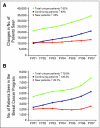Cancer care and cancer survivorship care in the United States: will we be able to care for these patients in the future?
- PMID: 20856750
- PMCID: PMC2790692
- DOI: 10.1200/JOP.0932001
Cancer care and cancer survivorship care in the United States: will we be able to care for these patients in the future?
Abstract
The combination of a shortfall in oncologists and primary care physicians and an increased number of patients using more health care resources raises concerns about our health care system's ability to accommodate future patients with cancer and cancer survivors.
Figures






Similar articles
-
Dissemination of cancer survivorship care plans: who is being left out?Support Care Cancer. 2021 Aug;29(8):4295-4302. doi: 10.1007/s00520-020-05915-x. Epub 2021 Jan 7. Support Care Cancer. 2021. PMID: 33415363
-
Cancer survivors' perspectives on delivery of survivorship care by primary care physicians: an internet-based survey.BMC Fam Pract. 2015 Oct 20;16:143. doi: 10.1186/s12875-015-0367-x. BMC Fam Pract. 2015. PMID: 26486311 Free PMC article.
-
Comparisons of patient and physician expectations for cancer survivorship care.J Clin Oncol. 2009 May 20;27(15):2489-95. doi: 10.1200/JCO.2008.20.3232. Epub 2009 Mar 30. J Clin Oncol. 2009. PMID: 19332716
-
Survivorship: adult cancer survivors.Prim Care. 2009 Dec;36(4):721-41. doi: 10.1016/j.pop.2009.08.001. Prim Care. 2009. PMID: 19913184 Review.
-
Implementing a survivorship care plan for patients with breast cancer.J Clin Oncol. 2008 Feb 10;26(5):759-67. doi: 10.1200/JCO.2007.14.2851. J Clin Oncol. 2008. PMID: 18258984 Review.
Cited by
-
Conception et mise en œuvre d’un programme de transition post-traitement pour les survivants du cancer.Can Oncol Nurs J. 2022 Feb 1;32(1):12-21. doi: 10.5737/236880763211221. eCollection 2022 Winter. Can Oncol Nurs J. 2022. PMID: 35280063 Free PMC article. French.
-
Survivorship care planning after the institute of medicine recommendations: how are we faring?J Cancer Surviv. 2011 Dec;5(4):358-70. doi: 10.1007/s11764-011-0196-4. Epub 2011 Oct 4. J Cancer Surviv. 2011. PMID: 21968543 Free PMC article. Review.
-
Practical Strategies for Optimizing and Integrating Palliative Care in Cancer.Curr Oncol Rep. 2018 Nov 13;20(12):97. doi: 10.1007/s11912-018-0742-6. Curr Oncol Rep. 2018. PMID: 30421161 Review.
-
Projections of cancer prevalence by phase of care: a potential tool for planning future health service needs.J Cancer Surviv. 2013 Dec;7(4):641-51. doi: 10.1007/s11764-013-0303-9. Epub 2013 Aug 7. J Cancer Surviv. 2013. PMID: 23921991
-
History and current status of the survivorship care program at the University of California, Los Angeles Jonsson Comprehensive Cancer Center (UCLA JCCC).J Cancer Surviv. 2024 Feb;18(1):5-10. doi: 10.1007/s11764-023-01522-x. Epub 2024 Jan 6. J Cancer Surviv. 2024. PMID: 38183578
References
-
- Salsberg E, Forte G: Trends in the physician workforce, 1980-2000. Health Aff (Millwood) 21:165-173, 2002 - PubMed
-
- Salsberg E, Grover A: Physician workforce shortages: Implications and issues for academic health centers and policymakers. Acad Med 81:782-787, 2006 - PubMed
-
- Kindig DA: Strategic issues for managing the future physician workforce. Baxter Health Policy Rev 2:149-182, 1996 - PubMed
-
- Warren J, Mariotto A, Meekins A, et al: Current and future utilization of services from medical oncologists. J Clin Oncol 26:3242-3247, 2008 - PubMed
-
- Goodman D, Fisher E: Physician workforce crisis? Wrong diagnosis, wrong prescription. N Engl J Med 358:1658-1661, 2008 - PubMed
Grants and funding
LinkOut - more resources
Full Text Sources

